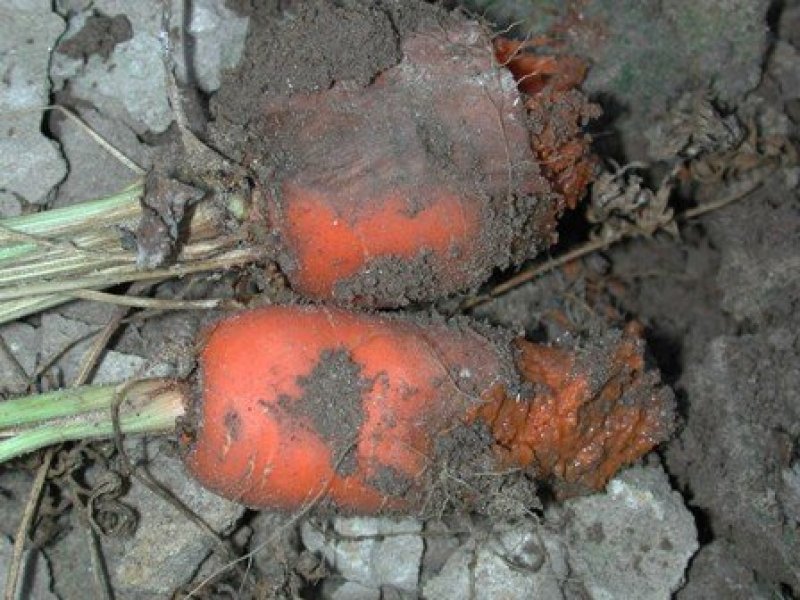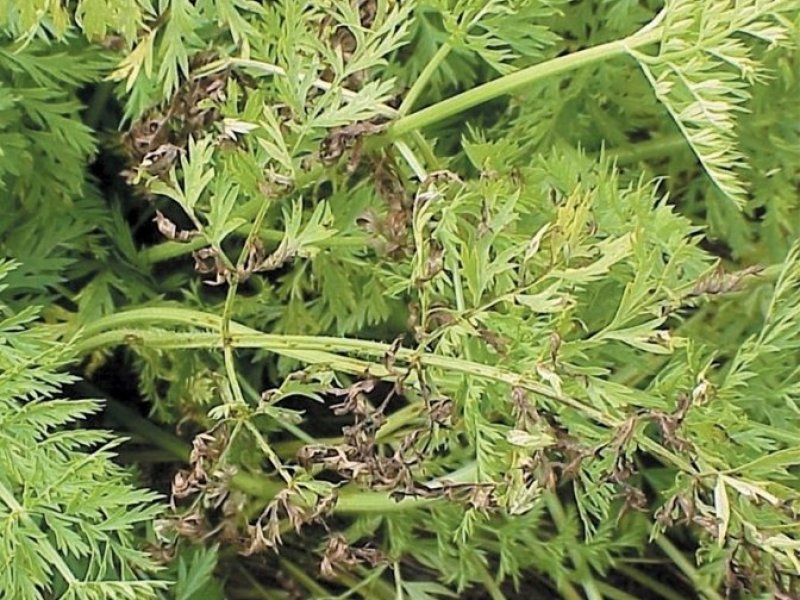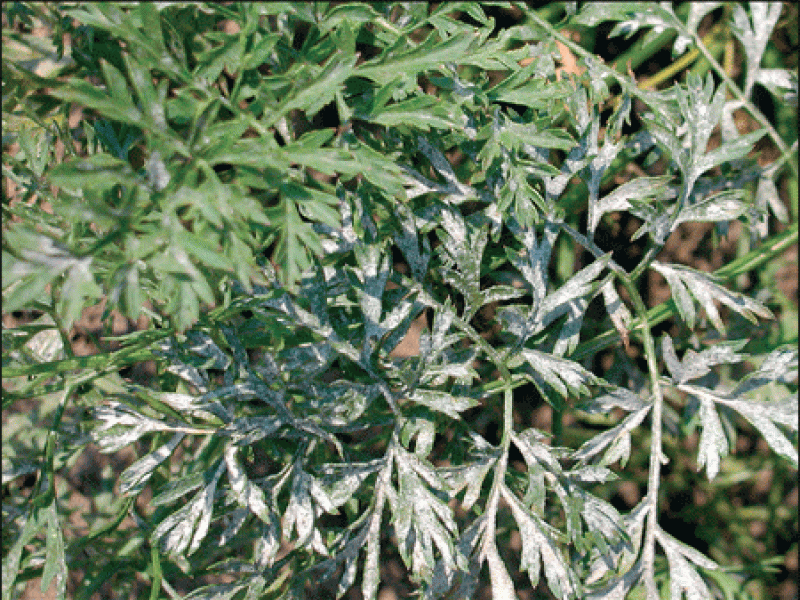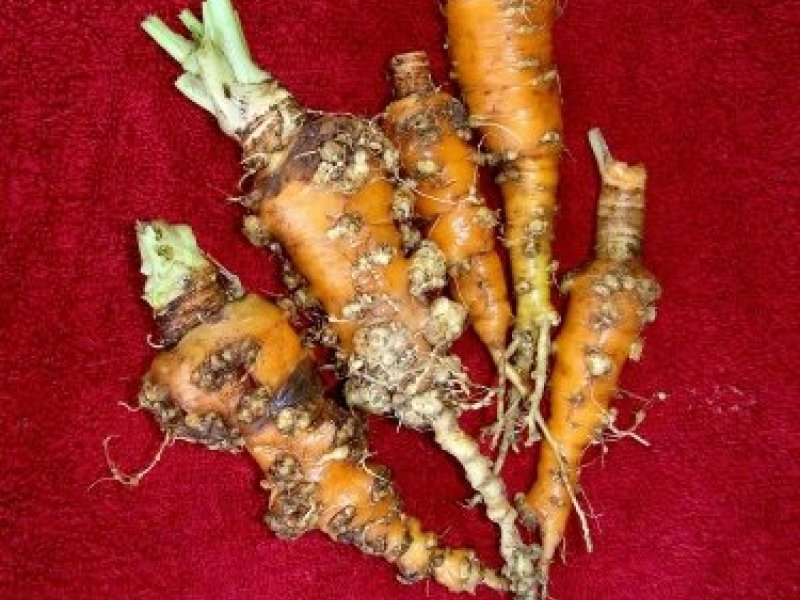|
African armyworm (Spodoptera exempta) The African armyworm can cause serious crop losses. Armyworms may cause indirect injury to the taproot by cutting stems and/or consuming foliage above ground. |
|
|
What to do:
|
|
Bacterial soft rot (Erwinia carotovora var. carotovora) Erwinia carotovora subsp. carotovora is a bacterium. Bacteria survive in decaying refuse and enter the root principally through cultivation wounds, harvest bruises, freezing injury, and insect openings. After infection, high humidity is essential for progress of the disease. When soft rot occurs in the field, it usually follows a period of water logging in low areas following excessive rain or irrigation. Carrots, potatoes, onions, crucifers, and celery are only a few of the many plants attacked.
The disease causes a soft, watery, slimy rot. The rotted tissues are grey to brown and may have a foul odour. It decays the core of the root. Also prolonged wet weather favours disease development. It is a serious transit and storage problem if affected carrots are not discarded. In the field, tops of rotted carrots turn yellow and wilt as roots break down. |
|
|
What to do:
|
|
Cottony soft rot (Sclerotinia sclerotiorum) The disease is caused by the fungus Sclerotinia sclerotiorum and is characterised by development of soft, watery rot of leaves, crowns and roots. Affected areas become covered with white, cottony fungal growth in which black, irregular, fungal resting bodies (sclerotia) form. The sclerotia enable the fungus to survive for long periods in the soil. This disease is a serious field and storage problem. If diseased roots are packed, extensive breakdown may occur during transit and storage. |
|
|
What to do:
|
|
Cutworms (Agrotis spp) Cutworms such as the black cutworm (Agrotis ipsilon) and the common cutworm, also known as the turnip moth (Agrotis segetum), attack carrot roots. Feeding on roots causes holes ranging from small and superficial to very large deep holes. |
|
|
What to do:
|
|
Damping-off on carrot (Phythium sp.) Damping-off diseases are caused by a complex of plant pathogens (disease inciting agents) including Alternaria spp., Fusarium spp., Pythium spp. and Rhizoctonia solani. These pathogenic fungi may cause rotting of seeds before emergence or death of seedlings after emergence. The most disposing factors are use of non-certified disease-free seeds and excessive watering of seed-beds or field plots. |
|
|
What to do:
|
|
Leaf blight (Alternaria dauci) The disease is caused by the fungus Alternaria dauci. Dark-grey to brown, angular spots form on leaves. Surrounding tissue yellows and affected leaves eventually die. Older leaves are attacked first and only in very severe cases are younger leaves affected. Large spots can girdle leaf petioles and kill leaves without spots developing on individual leaflets. During warm moist weather, dying of affected leaves may occur so rapidly that plants appear scorched. This fungus can also cause seedling damping-off. The fungus is seed-borne and survives in the soil crop debris. |
|
|
What to do:
|
|
Powdery mildew (Erysiphe polygoni) The disease is caused by the fungus Erysiphe polygoni (E. heraclei). It is characterised by the development of white, powdery fungal growth on leaves. Affected leaves become chlorotic and eventually die. The fungus is seed-borne. |
|
|
What to do:
|
|
Root-knot nematodes (Meloidogyne spp.) Various species of Meloidogyne cause galls or swellings on the fleshy tap-root. In warm climates M. incognita, M. javanica and M. hapla are the main species causing problem. The disease is a problem in carrots grown in sandy soils. |
|
|
What to do:
|
Geographical Distribution in Africa
Geographical Distribution of Carrot in Africa. Updated on 8 July 2019. Source FAOSTAT
Read more
Local names (Detailed)
Algeria: Jazar (Arabic)
Angola: Cenoura (Portuguese)
Cameroon: Carotte (French)
Congo: Karoté (Lingala)
Cote d'Ivoire: Karoté (Baoulé)
Ethiopia: Karoti (Amharic) (Kidane et al., 2018); Carrot (Tigrigna)
Kenya: Karoti (Swahili)
Mali: Karoti (Bambara)
Mauritius: Carotte (Creole); Carrot kalung (Tamoul)
Morocco: Jazar, Khizou (Arabic), Carotte cultivée (French) (Tahri et al., 2012)
Nigeria: Karoti (Yoruba), Carrot (Igbo, Hausa) (Aiyeloja et al., 2006)
Rwanda: Karoti (Kinyarwanda)
Senegal: Karot (Wolof); Karotë (Pulaar)
South Africa: Umnqathi (isi Xhosa) (Maroyi, A. (2017); Wortel (Afrikaans)
Tanzania: Karoti (Swahili)
Uganda: Karoti (Luganda)
Zambia: Karoti (Bemba)
Zimbabwe: Karoti (Shona)
General Information and Agronomic Aspects
Introduction
Daucus carota, commonly known as the carrot belongs to the family Apiaceae and the genus Daucus. It is a biennial plant that is widely cultivated for its edible root, which is consumed as a vegetable worldwide. The genus Daucus comprises about 75 species, with Daucus carota being the most well-known and commercially important species. Daucus carota is cultivated in various regions of Africa, including North Africa, East Africa, and parts of West Africa. It is well-suited to different climates and can be grown in cool climates both in the tropical and temperate regions. The plant prefers well-drained soil and requires moderate water supply.
Carrots are primarily utilized for culinary purposes, both raw and cooked. They are consumed in various forms, including salads, soups, stews, and as a standalone vegetable. They are valued for their crisp texture, sweet taste, and high nutritional content. Carrots are an excellent source of dietary fiber, antioxidants, vitamins, and minerals. They are particularly rich in beta-carotene, which is converted into vitamin A in the body. Vitamin A is essential for maintaining healthy vision, promoting proper immune function, and supporting overall growth and development. Vitamin A deficiency can lead to blindness and especially for children to a greater risk of dying from ailments such as measles, diarrhoea or malaria. Carrots also contain significant amounts of vitamin C, vitamin K, potassium, and other beneficial compounds that contribute to their health benefits. Young leaves are sometimes eaten raw or used as fodder.
The market for carrots is significant both globally and in Africa. Carrots are one of the most consumed and widely traded vegetables worldwide. They are readily available in supermarkets, grocery stores, and local markets in various forms. In Africa, the demand for carrots is driven by domestic consumption, with a growing interest in processed carrot products.
(Van der Vossen & Kahangi, 2004. Kew botanical gardens).
Species account
Carrot is slender, annual or biennial herbaceous plant that grows up to 1 to 3 feet (30 to 90 cm) tall.
Foliage: Leaves: are pinnately divided and deeply dissected into narrow segments. Flowers: The stem is coarsely hairy and, during flowering time produces flat-topped clusters of small flowers called umbels, with a central dark purple flower surrounded by white ones. The flowers eventually turn into dry, brown fruits called schizocarps, which have spiny bristles. Carrots have a long, edible taproot with other small sider roots which allows it to efficiently access water and nutrients from the soil. The taproot vary in color from orange to purple, red, white, or yellow, depending on the cultivar.
Carrots are biennial, meaning they complete their life cycle over two years. In the first year, they develop a rosette of leaves and store energy in their taproot. In the second year, they send up a flower stalk and produce seeds (Tran G., 2016).
Carrot varieties
Carrots exhibit significant variation in color, size, shape, flavor, and texture. They come in shades of orange, red, purple, yellow, and white, with sizes ranging from slender to stout. Flavors can vary from sweet to earthy, and textures can be tender or crisp. This diversity allows for versatile culinary applications and customization.
Table 1: Examples of carrot varieties and their qualities
Name |
Qualities |
Nantes |
Sweet, crisp, 6-7" cylindrical carrots, blunt tips |
Scarlet Nantes (F1, 65-75 days) |
Uniform, 6-8" carrots, perfect for fresh eating or storage |
Bolero (F1, 75 days) |
High-yielding, sweet Nantes-type carrot, good for storage. These carrots are 6-7" long with a 1 ½" crown and have a cylindrical shape. They are resistant to Alternaria Blight and Powdery Mildew. |
Nelson (F1, 58 days) |
Early Nantes carrot with uniform, deep orange color They have a sweet flavor, a uniform shape, and a deep orange color. They grow well in heavy soils. |
Yaya (F1, 60 days) |
Similar to Nelson, but slightly less sweet. holds well in the ground, good for fall sowing |
Napa (F1, 63 days) |
Produces 7-8" carrots with deep orange color performs well in heavy soils Resistant to Alternaria Blight and Powdery Mildew. |
Touchon (OP, French Heirloom, 70 days) |
Sweet and tasty, can be harvested at any size |
Parano (F1, 65 days) |
Beautiful 6-7" carrots, great fresh, cooked, or juiced They have a sweet flavor and maintain their crisp texture when cooked. |
Kaleidoscope Mix (60-70 days) |
Multicolor mix of red, purple, yellow, and orange carrots each 7-8" in length (18-20cm |
White Satin (F1, 70 days) |
Crisp, white 8" carrots, adds a different color to the carrot rainbow |
Merida (F1, 240 days) |
Storage-type Nantes variety, can be overwintered in the ground |
Purple Dragon (F1, 70 days) |
8-10" carrots with purple skin and bright orange core |
Cosmic Purple (F1, 73 days) |
Violet on the outside and orange in the middle, retains color when cooked |
Imperator |
Classic long, tapered roots, ideal for deep, fine tilth soil |
Autumn King (70 days) |
Long, 10-12" roots |
Atomic Red (65-75 days) |
Slim, tapered roots, retains red color after cooking |
Ecological conditions
Carrots can grow under a range of climatic conditions, but they perform best under moderate temperatures. They are mostly cultivated as a cool season crop. Seed germination occurs between 7degC and 30degC. Optimum air temperatures are 16-24degC. Soil temperatures above 25degC may reduce root quality, including root color. High temperatures can cause burning of young seedlings. For economic yields, carrots should be grown in tropical regions at altitudes above 700 m. Early-maturing carrot cultivars may grow in the lowlands, but yields will be low and roots will have a poor color.
Carrots grow best in a well-drained friable loam free of stones and hard soil clods. It is a short season crop of 2-3 months with the potential of high yields for family food security and fresh market sales. It does well in the cooler areas of Kenya under both rainfed and irrigated conditions.
Agronomic aspects
Carrots are propagated by seeds. Seeds are sown, often mixed with sand, 1/2 - 1 cm deep in drills 10-15 cm apart in finely prepared soils previously cultivated to a depth of at least 30 cm. Lightly aerate the soil by shallow digging before sowing carrots or sow them in ridge culture (small dams of 10 to 20 cm height) to facilitate mechanical weeding, thinning, and to limit soil borne diseases. In addition, this will allow easier penetration by the carrot root and will also improve water holding capacity.
Seedlings are thinned to 5-8 cm in the rows. Seed requirements (200 plants/m2 and 70% germination) for the dominant half-long carrot cultivars used in Asia, are 4-5 kg/ha. For bigger carrots, the density may be reduced to about 100 plants/m2. Carrots that bolt (produce seed) in between normal carrots should be pulled out and fed to livestock. Seed produced this way will not produce good quality carrots. Seed production under tropical highland (above 1200 m) conditions is possible by selecting and harvesting the best quality mature carrot roots and replanting them separately in a corner of the field. Bolting and seed setting soon follows.
Husbandry
Crop rotation is essential to reduce soil-borne diseases and pests. Mulching (rice straw or dried grass) after sowing is recommended to encourage germination. Seedlings may be earthed-up when roots start swelling to keep them cool and prevent green tops. Temperature of 15 to 20degC is optimal for seed development. In hot weather, light overhead shade is beneficial. Under such conditions carrots grow well under the canopy of fruit trees. Irrigation during dry spells is necessary to prevent irregular root development. Nutrient requirements of carrots are particularly high for potassium (200-300 kg/ha) and low to medium for nitrogen (0-90 kg/ha). Carrots are sensitive to high Chlorine concentrations and more susceptible to diseases at very high soil ph. Liming is recommended when pH is below 5.5. Well-decomposed organic manures are beneficial when applied moderately (10-20 t/ha). Fresh organic matter such as farmyard manure or manure from a leguminous crop can induce forked roots, which are difficult to clean and to market.
Young carrot seedlings are weak and grow slowly. Therefore, it is essential to keep weeds under control for the first few weeks after germination. Cultivate shallowly with a hoe.
Deep cultivation may injure the roots. Weeding and thinning of young plants can be very labor intensive, for which reason most families grow fairly small beds at any one time.
Intercropping
Because of their limited space requirements and early growing habits, carrots are ideal for intercropping between other crops such as tomatoes, lettuce or capsicums and because of their fragrant leaves can help keep pest levels low. Other crops good for intercropping with carrots include garlic, dwarf bean, onion, parsnip, leek, small peas, pea mange-tout (snow peas), and radish. The most profitable example of an association is that of carrots and leeks. Carrots have very deep roots that extract nutrients deep in the soil, whereas leeks have extremely superficial roots, which help the crop to extract nutrients near the soil surface. Moreover, carrots can drive away worms from leeks, while leeks can drive away flies from the carrots (TOF No. 8, page 8).
Harvest, post-harvest practices and markets
Harvesting
Carrots are mostly harvested manually by pulling up the roots at the leaves as long as the soil is moist and soft. If the soil has dried, it will be necessary to use either a spade or similar tool to loosen the soil and harvest the roots. Carrots are usually ready for harvesting 60-85 days after sowing. Mature roots should be orange-coloured internally down to the blunt tip.
A good market price can be fetched from young carrots with a fresh top, but leaving the top on dries out the root quickly and reduces the marketing period of the crop. An alternative is to trim the top back to about 2 cm and package attractively.
For mature carrots the tops are trimmed down completely to avoid storage rots before marketing. Carrots can remain in good condition for 100-150 days when the foliage is removed and they are stored at 1-4° C with 95-100% relative humidity. Carrots should be stored separately from other vegetables to prevent a bitter flavour induced by ethylene (a colourless gas with a sweet odour that is produced by many fruits and vegetables that accelerates the ripening process). Generally carrots store better when they are mature and harvested under moist conditions, and undamaged and free of diseases and pests.
Post-harvest practices.
Carrots bundled with leaves can be stored for up to three weeks in a cool place. However, for longer storage (100-150 days), it is recommended to remove the foliage, store the carrots at 1-4°C with 95-100% humidity, and keep them separate from other vegetables to prevent a bitter taste caused by ethylene exposure. High dry matter content, low organic matter soil, mature harvesting under moist conditions, and undamaged, disease-free carrots contribute to better storage. Carrots can be graded by weight (A: <50g, B: 50-200g, C: 200-400g, D: >400g). Exported carrots are washed, graded, and packaged in perforated polythene bags. However, small-scale farmers in Africa may experience post-harvest losses by transporting topped carrot roots in sacks to local markets (Van der Vossen, & Kahangi, 2004).
Value addition and markets
Carrots enjoy widespread consumption and have diverse markets globally. Key consumers for carrots include households, restaurants, food processing companies, and the fresh produce industry. Carrots are widely used in various culinary applications, including salads, soups, stews, side dishes, and as ingredients in processed foods like juices, purees, and baby food. The value addition of carrots involves processing them into various products such as carrot juice, puree, frozen carrot cubes, and dehydrated carrot flakes. These processed forms have an extended shelf life and can be used in the food industry as ingredients or additives in a wide range of products.
Carrots hold significant market value globally and are widely produced and exported. According to NAB 2022 report, global carrot production has witnessed a growth trajectory, rising from 40,265,109 tonnes in 2015 to 44,762,859 tonnes in 2019. Furthermore, predictions indicate a continued upward trend in the coming years. Leading countries in global carrot production and export include China, the United States, Russia, Ukraine, and Poland. Europe is reported to be the fastest growing market for carrots, whilst North America namely Canada and the United States of America hold the largest carrot markets.
In Africa, several countries are prominent in carrot production and export. Based on estimates from FAOSTAT 2021, the top six leading carrot producers in Africa from 2016 to 2020 include: Algeria, Morocco, Egypt, Kenya, Nigeria and South Africa. (beef2live.com, NAB, 2022, FAOSTAT, 2021).
Nutritional value and recipes
Carrots are a nutritious vegetable that offer a wide range of health benefits. They are rich in vitamins, minerals, and antioxidants, while being low in fat and proteins. Carrots have a low glycemic index, which is especially beneficial for diabetic patients. The water content of carrots varies from 86% to 95%, and the edible portion contains about 10% carbs, mainly in the form of sugars like sucrose and glucose.
The fiber present in carrots aids digestion and promotes weight loss. Vitamin A, crucial for vision, development, and immune function, is found in higher amounts in orange carrots. Cooking carrots and consuming them with fat enhances the absorption of vitamin A compared to eating them raw. Biotin (vitamin H) supports fat and protein metabolism, while B6 is involved in converting food into energy. Vitamin K1 and calcium are important for blood coagulation and bone health, and potassium helps control blood pressure.
Carrots are packed with carotenoids, powerful antioxidants that can reduce the risk of heart disease, degenerative diseases, and certain types of cancers. Lutein, found in carrots, plays a role in preventing age-related macular degeneration. Additionally, red and purple carrots contain lycopene, which may lower the risk of cancer and heart disease. (Bjarnadotti, 2015, da Silva Dias, 2014, Varshney & Mishra, 2022).
Table 2: Proximate nutritional composition of 100 g of Carrot.
Food Name |
Carrot, peeled, raw |
Carrot, peeled, boiled, drained (without salt) |
Carrot, peeled, stewed (without salt) |
Recommended daily allowance (approx.) for adultsa |
Proximate composition and dietary energy |
|
|
|
|
Edible conversion factor |
0.83 |
1 |
1 |
|
Energy (kJ) |
124 |
132 |
129 |
9623 |
Energy (kcal) |
30 |
32 |
31 |
2300 |
Water (g) |
90.6 |
90 |
90.2 |
2000-3000c |
Protein (g) |
0.7 |
0.8 |
0.8 |
50 |
Fat (g) |
[0.2] |
0.3 |
0.2 |
<30 (male), <20 (female)b |
Carbohydrate available (g) |
4.5 |
4.8 |
4.7 |
225 -325g |
Fibre (g) |
3.2 |
3.4 |
3.4 |
30d |
Ash (g) |
0.6 |
0.7 |
0.7 |
|
Mineral composition |
|
|
|
|
Ca (mg) |
33 |
34 |
35 |
800 |
Fe (mg) |
0.6 |
0.5 |
0.6 |
14 |
Mg (mg) |
17 |
11 |
17 |
300 |
P (mg) |
25 |
24 |
26 |
800 |
K (mg) |
251 |
120 |
261 |
4,700f |
Na (mg) |
35 |
21 |
37 |
<2300e |
Zn (mg) |
0.14 |
0.11 |
0.14 |
15 |
Se (mcg) |
0 |
0 |
0 |
60 |
Cu (mg) |
0.07h |
0.07h |
0.08h |
0.9 |
Bioactive compound composition |
|
|
|
|
Vit A RAE (mcg) |
589 |
564 |
552 |
800 |
Vit A RE (mcg) |
1180 |
1130 |
1110 |
800 |
Retinol (mcg) |
0 |
0 |
0 |
1000 |
b-carotene equivalent (mcg) |
7070 |
6770 |
6630 |
600 – 1500g |
VIT D (mcg) |
0h |
0h |
0h |
5 – 15* |
VIT E (mg) |
0.72h |
0.76h |
0.75h |
9 |
Thiamin (mg) |
0.04 |
0.03 |
0.04 |
1.4 |
Riboflavin (mg) |
0.03 |
0.02 |
0.03 |
1.6 |
Niacin (mg) |
0.22 |
0.2 |
0.2 |
18 |
VIT B6(mg) |
0.25h |
0.19h |
0.23h |
1.3 |
Folate (mcg) |
18 |
10 |
13 |
400f |
Vit B12 (mg) |
0 |
0 |
0 |
3 |
Vit C (mg) |
5.5 |
2 |
5 |
60 |
Source (Nutrient data): FAO/Government of Kenya. 2018. Kenya Food Composition Tables. Nairobi, 254 pp. http://www.fao.org/3/I9120EN/i9120en.pdf
$ Draining the water several times leaches away water soluble nutrients significantly.
a Lewis, J. 2019. Codex nutrient reference values. Rome. FAO and WHO
b NHS (refers to saturated fat)
c https://www.hsph.harvard.edu/nutritionsource/water/
d British Heart Foundation
e FDA
f NIH
g Mayo Clinic
hWest African food composition table, https://www.fao.org/3/ca7779b/CA7779B.PDF
Complimentary recipes
1. Mchicha (Amaranthus spp.) and Carrot
Ingredients
2–4 bundles of leafy amaranths with young shoots (250–500 g/bundle)
1or 2 onions
Cooking oil
2 carrots
Salt
Preparation
• Select the amaranths and remove any dirt, unwanted leaves of other plants or old yellowing leaves of amaranths. Peel off skin of young stems/shoots.
• Wash the leafy amaranths with plenty of cold water and drain it.
• Peel and clean the onions then slice them into small pieces.
• Wash carrot fingers and scrap the outer skin to clean them. Chop them into small pieces of any shape you want (optional).
• Pour some oil into a cooking pot.
• Fry the onion and add the chopped carrots into the hot oil to fry together with the onions (carrot is an optional addition).
• Before onions turn golden brown, add the washed amaranth.
• Cover the pot with a lid and let the mixture cook for one and half minutes.
• Stir to mix well the onions, amaranths and carrots. Let the mixture cook for another one and half minutes.
• Add salt to taste and check if the amaranth is well cooked.
• It is served as a relish with ugali, rice, bananas, cassava, pancakes etc. or may be served as a side dish
• Cooked amaranth also provides a nice food decoration on meal plate with its green color.
2. Mnavu (African nightshade) and carrot
Ingredients
100 g nightshade leaves
60 g onions
40 g carrots
5 tablespoons cooking oil
¼ cup milk
½ cup groundnut flour/ peanut butter
Salt to taste
Preparation
• Sort the nightshade leaves, wash and chop finely
• Clean, wash and chop the onions
• Wash, peel and grate the carrots
• Fry the onions with carrots and salt lightly
• Add chopped nightshade and stir well, cover the pan for 1 minute and simmer
• Mix the milk and groundnut flour/peanut butter then add into the vegetables while stirring for 5 minutes
• Season to taste and serve while hot as a relish
Variations
• Use coconut milk instead of milk
• Use tomatoes instead of carrots
• Mix with other vegetables to reduce bitterness
• Use cream, eggs or meat instead of milk
• Garnish the vegetables with slices of tomatoes when serving.
Remarks
The vegetable is ideal for young children as it has many ingredients that mask the bitterness
Could also be used for sandwich
Care should be taken not to add or use a lot of carrots as they mask the main vegetable.
3. Mgagani (Spider plant) and carrot
Ingredients
300 g or 2 handfuls spider plant
1 onion
1 carrot about 125 g
75 g tomato
4 tablespoons cooking oil
2 teaspoonfuls of groundnut flour
4 tablespoonfuls of coconut milk
Preparation
• Select the tender leaves of the spider plant, wash and chop finely
• Boil water, add salt and chopped spider plant and let it boil for 6 minutes or until soft
• Mash the spider plant after blanching (the vegetables reduce in size when mashed so be sure to have enough quantity)
• Clean, wash and slice the onions
• Wash, peel and grate the carrots
• Prepare coconut milk and groundnuts
• Fry the onions and carrots lightly
• Add spider plant and stir well, simmer for 5 minutes while stirring
• Mix coconut milk with groundnut flour and add into the vegetables while stirring for 5 minutes
• Season to taste; serve while hot as a relish
Variation
• Mix with other vegetables to reduce bitterness
• Use milk or cream instead of coconut milk
• Use peanut butter instead of groundnut flour
Fresh Quality Specifications for the Market in Kenya
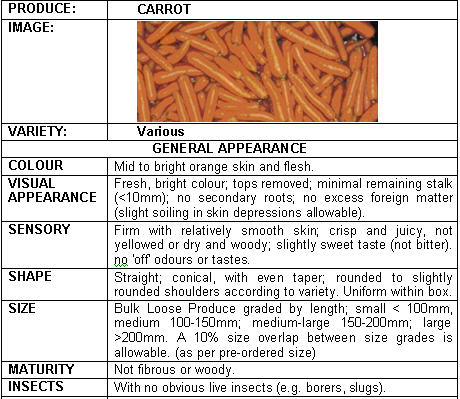 |
| Ⓒ S. Kahumbu, Kenya |
| Root-knot nematodes (Meloidogyne spp.) Various species of Meloidogyne cause galls or swellings on the fleshy tap-root. In warm climates M. incognita, M. javanica and M. hapla are the main species causing problem. The disease is a problem in carrots grown in sandy soils. What to do:
|
| Cutworms such as the black cutworm (Agrotis ipsilon) and the common cutworm, also known as the turnip moth (Agrotis segetum), attack carrot roots. Feeding on roots causes holes ranging from small and superficial to very large deep holes. What to do:
|
| African armyworm (Spodoptera exempta) The African armyworm can cause serious crop losses. Armyworms may cause indirect injury to the taproot by cutting stems and/or consuming foliage above ground. What to do:
|
| Cottony soft rot (Sclerotinia sclerotiorum) The disease is caused by the fungus Sclerotinia sclerotiorum and is characterised by development of soft, watery rot of leaves, crowns and roots. Affected areas become covered with white, cottony fungal growth in which black, irregular, fungal resting bodies (sclerotia) form. The sclerotia enable the fungus to survive for long periods in the soil. This disease is a serious field and storage problem. If diseased roots are packed, extensive breakdown may occur during transit and storage. What to do:
|
| Leaf blight (Alternaria dauci) The disease is caused by the fungus Alternaria dauci. Dark-grey to brown, angular spots form on leaves. Surrounding tissue yellows and affected leaves eventually die. Older leaves are attacked first and only in very severe cases are younger leaves affected. Large spots can girdle leaf petioles and kill leaves without spots developing on individual leaflets. During warm moist weather, dying of affected leaves may occur so rapidly that plants appear scorched. This fungus can also cause seedling damping-off. The fungus is seed-borne and survives in the soil crop debris. What to do:
|
| Powdery mildew (Erysiphe polygoni) The disease is caused by the fungus Erysiphe polygoni (E. heraclei). It is characterised by the development of white, powdery fungal growth on leaves. Affected leaves become chlorotic and eventually die. The fungus is seed-borne. What to do:
|
| Damping-off on carrot (Phythium sp.) Damping-off diseases are caused by a complex of plant pathogens (disease inciting agents) including Alternaria spp., Fusarium spp., Pythium spp. and Rhizoctonia solani. These pathogenic fungi may cause rotting of seeds before emergence or death of seedlings after emergence. The most disposing factors are use of non-certified disease-free seeds and excessive watering of seed-beds or field plots. What to do:
|
| Bacterial soft rot (Erwinia carotovora var. carotovora) Erwinia carotovora subsp. carotovora is a bacterium. Bacteria survive in decaying refuse and enter the root principally through cultivation wounds, harvest bruises, freezing injury, and insect openings. After infection, high humidity is essential for progress of the disease. When soft rot occurs in the field, it usually follows a period of water logging in low areas following excessive rain or irrigation. Carrots, potatoes, onions, crucifers, and celery are only a few of the many plants attacked.
The disease causes a soft, watery, slimy rot. The rotted tissues are grey to brown and may have a foul odour. It decays the core of the root. Also prolonged wet weather favours disease development. It is a serious transit and storage problem if affected carrots are not discarded. In the field, tops of rotted carrots turn yellow and wilt as roots break down. What to do:
|
Contact Information
- Amiran Kenya Ltd. seeds@amirankenya.com
- Corner Shop Nairobi:cornershop@africaonline.co.ke, +254 (0) 0716 905 486, (20) 2712268/9
- East African Seed Company Ltd: www.easeed.com, + 254 (20) 6652101-4, +254 (0) 722 207 747
- Green Dreams: info@organic.co.ke +254 (0) 724 781 971/ 0722 562 717001
- Horticultural Crops Directorate: info@agricultureauthority.go.ke, +254 20 2536869, 0722 200 556
- Horticultural Research Institute, Thika: director.hri@kalro.org. +254 (20) 2055038,
- Kalimoni Greens: www.kalimonigreens.com , +254 (0) 708 278 273
- Karen Provision Stores:kps@nbi.ispkenya.com +254 20 882 252, 0736 371 437
- Muthaiga Green Grocers, Nairobi
- Nakumatt Supermarket: info@nakumatt.net, +254 (0) 733 632 130, 0722 204 931, (20) 3599991-4
- Simlaw Seeds Co. Ltd: info@simlaw.co.ke, +254 (0) 0722 200 545 / 0734 811 861, (20) 2215067
- Foshan Mafrika Stock And Supplies. Supplier From South Africa. Supply orange red carrot varieties. Web page. https://globaltradeplaza.com/member/foshan-mafrika-stock-and-supplies
- Modern Enterprise For Business And Supplies. Supplier From Egypt. Supply fresh carrots web page. https://www.tradeindia.com/modern-enterprise-for-business-supplies-12303491/product-services.html
- Fanuel Beyene Trading. Supplier From Ethiopia
Uchumi Supermarket: info@uchumi.com +254 20 8020081 - 5, 0733 410 028, - Zuchinni Green Grocers, Nairobi. +254 (20) 2215067
References and information links
References
1. Agricultural Information and Resource Centre (2003): Fruits and Vegetables Technical Handbook.
2. CABI. (2004). Crop Protection Compendium, 2004 Edition. (c) CAB International Publishing. Wallingford, UK. www.cabi.org
3. Carrotaid.org. Production manuals for carrots. https://carrotaid.org/reports/carrot-manual.pdf
4. Daucus carota L. in GBIF Secretariat (2021). GBIF Backbone Taxonomy. Checklist dataset https://doi.org/10.15468/39omei accessed via GBIF.org on 2021-12-20.
5. East African Seed Co. Ltd. Africa's Best Grower's Guide www.easeed.com
6. Herold, W. (1919). A contribution to the knowledge of Agrotis segetum, Schiff. Zeitschrift fur angewandte Entomologie, 1:47-59.
7. Madge, D., Jaeger, C., Clarke, S. (2003). Agriculture notes. Organic farming: Carrot production and marketing. State of Victoria, Department of Primary Industries. www.dpi.vic.gov.au
8. Ministry of Agriculture and Rural Development (Kenya) and Japan International Cooperation Agency (2000). Growing Manual for Local and Export Vegetables. Reprinted by Agricultural Information Resource Centre (Nairobi, Kenya). 274 pp.
9. Neergaard P. (1945). Danish Species of Alternaria and Stemphylium. London, UK: Oxford University Press.
10. Nutrition Data www.nutritiondata.com.
11. Pests of carrot: www.ipm.ncsu.edu
12. Sherf, A. F., Macnab, A. A. (1986). Vegetable Diseases and Their Control. 2nd. Edition. A Wiley-Interscience Publication. ISBN: 0 471 05860 2
13. University of Illinois Extension. www.urbanext.uiuc.edu
14. Bjarnadotti, A. (2015). Carrots 101: Nutrition facts and health benefits. Authority Nutr.https://www.healthline.com/nutrition/foods/carrots
15. da Silva Dias, J. C. (2014). Nutritional and health benefits of carrots and their seed extracts. Food and Nutrition Sciences, 5(22), 2147.https://www.scirp.org/html/5-2701422_52066.htm?crsi=662496660&cicada_org_src=healthwebmagazine.com&cicada_org_mdm=direct.
16. Varshney, K., & Mishra, K. (2022). An analysis of health benefits of carrot. International Journal of Innovative Research in Engineering & Management (IJIREM), 9, 211-214.https://www.researchgate.net/profile/Kirti-Mishra-9/publication/359863991_An_Analysis_of_Health_Benefits_of_Carrot/links/626914028e6d637bd1024749/An-Analysis-of-Health-Benefits-of-Carrot.pdf
17. Tran G., 2016. Carrot (Daucus carota). Feedipedia, a programme by INRAE, CIRAD, AFZ and FAO. https://www.feedipedia.org/node/539 Last updated on April 7, 2016, 18:42
18. NAB. (2022). Market intelligence report: Carrots. Retrieved June 28, 2023, from https://www.nab.com.na/wp-content/uploads/2022/04/Market-Intelligence-Report-Carrots.pdf
Information Source Links
- Agricultural Information and Resource Centre (2003): Fruits and Vegetables Technical Handbook.
- CABI. (2004). Crop Protection Compendium, 2004 Edition. © CAB International Publishing. Wallingford, UK. www.cabi.org
- East African Seed Co. Ltd. Africa's Best Grower's Guide www.easeed.com
- Herold, W. (1919). A contribution to the knowledge of Agrotis segetum, Schiff. Zeitschrift für angewandte Entomologie, 1:47-59.
- Madge, D., Jaeger, C., Clarke, S. (2003). Agriculture notes. Organic farming: Carrot production and marketing. State of Victoria, Department of Primary Industries. www.dpi.vic.gov.au
- Ministry of Agriculture and Rural Development (Kenya) and Japan International Cooperation Agency (2000). Growing Manual for Local and Export Vegetables. Reprinted by Agricultural Information Resource Centre (Nairobi, Kenya). 274 pp.
- Neergaard P. (1945). Danish Species of Alternaria and Stemphylium. London, UK: Oxford University Press.
- Nutrition Data www.nutritiondata.com.
- Pests of carrot: www.ipm.ncsu.edu
- Sherf, A. F., Macnab, A. A. (1986). Vegetable Diseases and Their Control. 2nd. Edition. A Wiley-Interscience Publication. ISBN: 0 471 05860 2
- University of Illinois Extension. www.urbanext.uiuc.edu
- https://www.webmd.com/diet/health-benefits-carrots
- https://www.webmd.com/food-recipes/benefits-carrots
- https://gardenerspath.com/plants/vegetables/best-carrot-varieties/
- https://beef2live.com/story-ranking-countries-produce-carrots-0-212999
Review Process
Dr. Patrick Maundu, James Kioko, Charei Munene and Monique Hunziker, April 2024


